
Châtenay-Malabry (FR - 92290), September 25, 2023
EFITA newsletter / 1079 - European Federation for Information Technology
in Agriculture, Food and the Environment
The informatique-agricole.org site offers you the possibility of subscribing
the RSS feeds of its two newsletters
See RSS feeds
to implement to ensure that you continue to receive this newsletter
To unsubscribe
this newsletter, please contact me directely: guy.waksman(a)laposte.net
if this
link Unsubscribe does not work.

To correspond with me (GW), please use this address: guy.waksman(a)laposte.net
To subscribe the efita newsletter (please ask your friends and colleagues
to test this link)
Efita
Newsletters subscription
Avant l'informatique / Before computers
|
25/09/2023
|
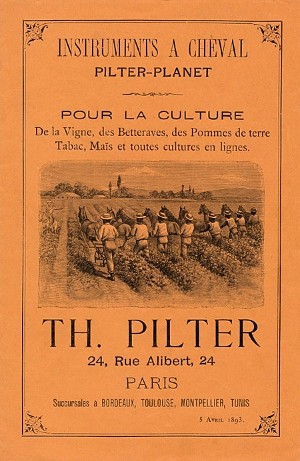 |
|
Weekly newsletters about ICT in Agriculture in English and French
Both newsletters have around 5000 subscribers.
>>> Last weekly EFITA Newsletters in English (created in 1999)
Efita
Newsletters
>>> Last weekly AFIA Newsletters in French (created more than
20 years ago in 1997) Afia
Newsletters
>>> Statistics
for the latest efita newsletter
>>> Latest
issue of the afia newsletter
>>> Latest
available satistics for the afia newsletter
AgTech: barriers to adoption
|
30
- 25/09/2023
|
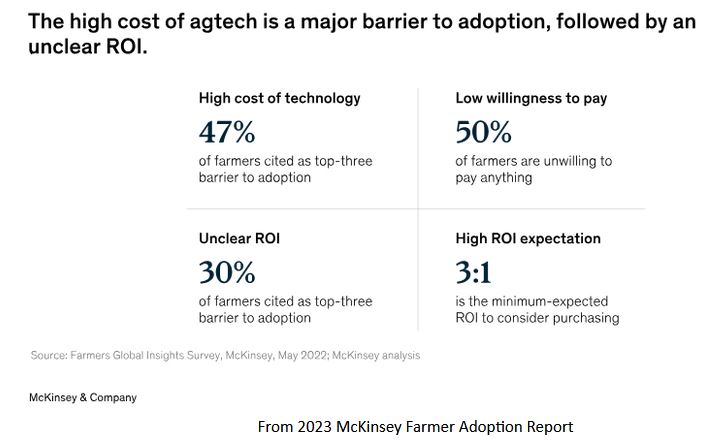 |
|
VISION Conference
January 22-24, 2024, Glendale, AZ
The VISION Conference has firmly established itself as the premier gathering
for forward-thinking executives in the ag tech community. This event serves
as a critical platform where industry leaders come together to chart the
strategic roadmap for the adoption of the latest innovative technologies
and systems. Our primary focus is on the key drivers that will transform
the agribusiness industry within the next 3 to 5 years.
VISION takes an immersive look at how new data and tech trends are fundamentally
reshaping the agribusiness landscape. Discover the latest solutions that
are revolutionizing how the industry operates, allowing for more efficient
and sustainable production of food, feed, fiber, and fuel in the coming
years.
VISION is not just a conference; it's an opportunity for cross-functional
problem solving and collaboration. Join us for interactive sessions, insightful
educational content, and executive-level networking that will empower you
with the knowledge and connections needed to drive your organization forward.
See thevisionconference.com
Der Sämann, von Albin Egger-Lienz (1868-1926)
|
01
- 25/09/2023
|
 |
|
Der Sämann, von Albin Egger-Lienz (1868-1926)
|
02
- 25/09/2023
|
 |
|
FutureFarming.com
> Unmanned tractor is already partially fulfilling high expectations
Dutch Arable farmer Jan Pieter Evenhuis was able to put the autonomous
Steyr Expert 4130 to work.
> Weed control: Sentera launches new precision weed technology
Sentera announced the launch of its Aerial WeedScout technology, a precision
weed control solution that reduces post-emergent herbicide application
by up to 70%.
> Autonomous system: First autonomous Case IH Magnum with Raven conversion
kit
At a field demo of Case IH in Austria, the machine manufacturer recently
showed the first autonomous Case IH Magnum.
> Glyphosate: Research: loss of glyphosate would cost farmers and the
environment
What would happen if glyphosate were no longer available?
> Soil health: DNA soil analysis, what’s involved and the benefits
it provides
DNA testing of the soil microbiome is becoming more common in many crop-growing
countries.
> Planting: Variable planting: simple technique, difficult to define
results
Variable planting based on variation in the soil is simple. Achieving
results with it is something else.
> Why do wide tires cause deeper soil compaction? Science explains
A broader tire pushes its ground pressure deeper into the soil. This is
why.
> Farming costs: Will AI and precision agriculture lower farming costs?
Farmers are seeking innovative ways to lower costs and improve profitability.
Read more
> Soil health: ‘Super wide tires or tracks conceal a deeper danger’
The pressure a farming machine exerts on the soil is a delicate balance
between its weight and the surface area it touches.
> FIRA USA: Efficient lasers and hoes controlled by LiDAR sensors at
FIRA USA
FIRA USA attracted a little over 2,000 visitors who saw various autonomous
robots and smart weeders in action.
> Autonomous system: Mojow Autonomous Solutions advances autonomy with
Versatile
The Canadese company Mojow, a developer of autonomous software for agricultural
machines, announced a partnership with tractor manufacturer Versatile.
> Weed control: Sentera launches new precision weed technology
Sentera announced the launch of its Aerial WeedScout technology, a precision
weed control solution that reduces post-emergent herbicide application
by up to 70%.
> Autonomous tractor: Unmanned tractor is already partially fulfilling
high expectations
Dutch Arable farmer Jan Pieter Evenhuis was only able to put the autonomous
Steyr Expert 4130 to work.
> Variable planting: Variable planting: simple technique, difficult
to define results
Variable planting based on variation in the soil is simple. Achieving
results with it is something else.
> Autonomous system: First autonomous Case IH Magnum with Raven conversion
kit
At a field demo of Case IH in Austria, the machine manufacturer recently
showed the first autonomous Case IH Magnum.
> Claas, AgXeed and Amazone in first manufacturer-independent autonomy
alliance
Claas, AgXeed, and Amazone, are collaborating to establish the world's
first manufacturer-independent platform for autonomous technology.
> Regenerative: Let nature do more work with regenerative agriculture
Regenerative agriculture is based on healthy soil with high biodiversity
in which nature works together with the farmer and the farmer with nature.
> Field robots: Calling all ag field and harvest robot sellers for
2024
Future Farming is relaunching its mission to update and enhance its Field
Robots Buyer’s Guide for 2024. Be part of the ultimate agricultural robot
buying guide – the fourth edition already.
> Acid-tolerance: Australian scientists develop acid-tolerant chickpea
varieties
Scientists in Australia are working to give grain growers access to acid-tolerant
chickpea varieties.
> NEXAT System: Nexat tool carrier bridges soil compaction
Terrakamp’s Nexat system generated a lot of buzz at the Farm Progress
Show 2023.
> Autonomous tractors: ‘Pioneering farmer sees challenges and potential
in unmanned tractor’
Dutch arable farmer Brian Salomé tests the autonomous Steyr tractor on
his farm.
> Hybrid tractor: Hybrid Steyr Tractor a step further
Tractor manufacturer Case IH/Steyr showed a second version of the hybrid
Steyr tractor.
See futurefarming.com
Average score obtained by country on reading assessments / Score moyen
obtenu par pays aux évaluations en lecture
|
01
- 25/09/2023
|
 |
|
Misery and disorder in the Sahel / Coups d'état en Afrique sub-saharienne
: le bonheur de Poutine
|
02
- 25/09/2023
|
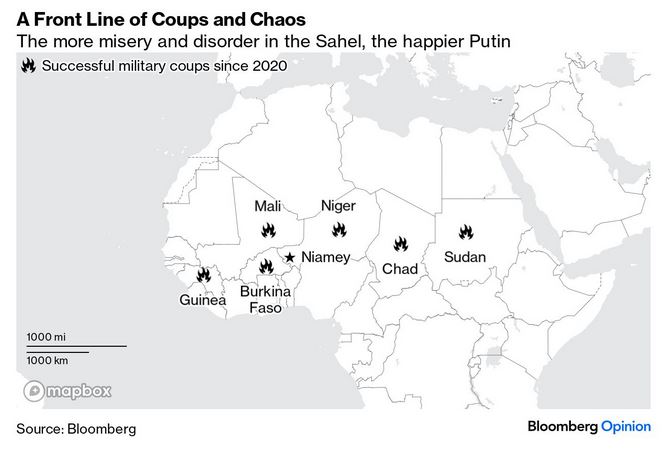 |
|
US Shortage of Ammunition / Pas assez d’armement
|
03
- 25/09/2023
|
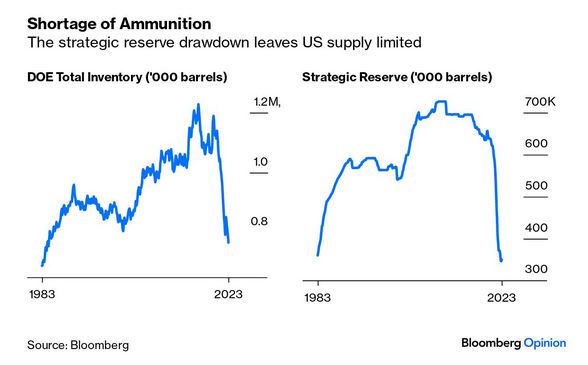 |
|
NHS waiting list and inactivity because of long-term sickness / Incroyable
liste d’attente au Royaume-Uni
|
04
- 25/09/2023
|
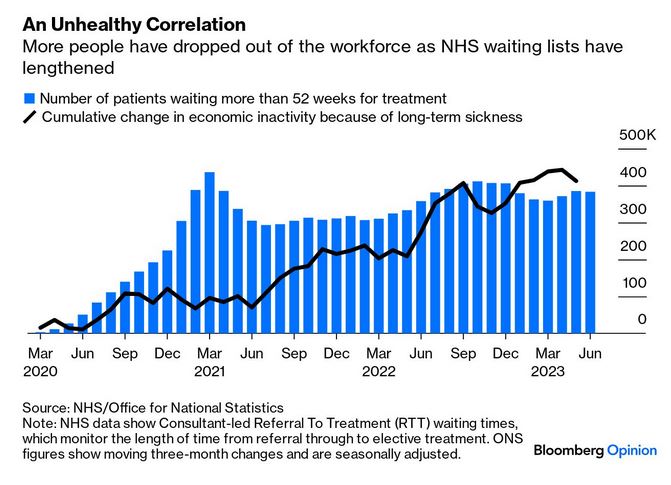 |
|
The Racial Murder Gap
|
05
- 25/09/2023
|
 |
|
S&P 500 Index led by a minority of strong companies
|
06
- 25/09/2023
|
 |
|
ADHD medication up / Trouble déficitaires de l'attention avec ou sans
hyperactivité en hausse
|
08
- 25/09/2023
|
 |
|
Safer States for Black Residents
|
09
- 25/09/2023
|
 |
|
US vs World: normal US relative decline
|
10
- 25/09/2023
|
 |
|
Global Ag Tech Initiative
> Robotics Plus Launches Multi-Use Autonomous Vehicle for Sustainable
Orchard and Vineyard Production
Prospr automates a variety of tree crop tasks, including intelligent spraying,
to improve efficiency and alleviate labor challenges.
> Agtonomy, On-Target Collaborate to Advance All-Electric Implement
Ecosystems
The first all-electric, electrostatic smart sprayer prototype designed
for specialty crop producers makes its public debut at FIRA USA.
> AMVAC: Trending Forward in Ag Technology
Discover how AMVAC is shaping the future of agriculture with its forward-thinking
approach to technology. Through groundbreaking solutions and partnerships,
AMVAC is at the forefront of agricultural innovation. Dive into their
journey of enhancing crop protection and optimizing yield.
> Tech Hub LIVE Conference and Expo Celebrates Resounding Success in
Des Moines, Iowa
This year's conference experienced unprecedented success with over 700
in attendance — a remarkable 15% growth from the previous year.
> AGCO to Build Sustainable Test Farm in North Dakota
”Dakota Smart Farm” is dedicated to developing sustainable farming practices
and high-value retrofit precision technology solutions.
> Multispectral Imaging in Precision Farming and Its Applications in
India
Multispectral imaging offers a data-driven approach to enhance crop health,
optimize resource use, and revolutionize Indian agriculture.
> Pitch AgriHack 2023: Unleashing Agritech Innovation in Africa
Awarding a total prize pool of USD 45,000, the competition celebrated
the brilliance of young minds that are reshaping the future of African
agriculture.
> Five Experts to Share Insights at State of the Ag Tech Industry Webinar
September 27
Our experts will explore the trends for the future advancement and also
the barriers to the adoption of ag tech.
> Pyka and Dole Successfully Complete Trial Phase of Autonomous Spray
Aircraft
Dole incorporates Pelican Spray to advance smart farming and sustainability
goals.
See globalagtechinitiative.com
Agfundernews.com
> Equilibrium & Bosch Growers submit winning bids for AppHarvest’s
KY greenhouses, by Jennifer Marston
> ALORA reactivates dormant genes to unlock ‘best performing salt-tolerant
rice plant in the world’, by Elaine Watson
> Cultivating change: How
can sustainable agtech empower smallholder farmers in Latin America?
> Is
Silicon Valley still killing agtech? By Sarah Nolet, Co-Founder &
General Partner - Tenacious Ventures
> Data snapshot: Climate and forestry solutions notably absent from
Indonesia’s agrifoodtech investment landscape, by Jennifer Marston
> Food companies aren’t all walking the talk on regenerative agriculture,
says FAIRR investor network, by Elaine Watson
See agfundernews.com
“Schnitter” [Reaper], von Albin Egger-Lienz – c. 1920, left figure
in the painting “Drei Schnitter”
|
03
- 25/09/2023
|
 |
|
Saemann und Teufel (1921)
|
04
- 25/09/2023
|
 |
|
The Emperor Of Ultra-Processed Foods Has No Clothes, by Chuck Dinerstein,
MD, MBA — July 17, 2023
According to the common narrative, ultra-processed foods are evil, unhealthy,
and unnatural. But a new contrarian study in the Journal of Nutrition
demonstrates that a diet containing 91% ultra-processed foods was far
healthier than the typical American diet and, get this, well aligned with
Dietary Guidelines for Americans. When it comes to shaming and blaming
UPFs, the emperor has no clothes.
See
acsh.org
Moravec's paradox analyzed by “Software is Feeding the World”
.../...
Moravec's paradox is the observation by artificial intelligence and robotics
researchers that, contrary to traditional assumptions, reasoning requires
very little computation, but sensorimotor and perception skills require
enormous computational resources.
The principle was articulated by Hans Moravec, Rodney Brooks, Marvin Minsky
and others in the 1980s.
Moravec wrote in 1988: It is comparatively easy to make computers exhibit
adult level performance on intelligence tests or playing checkers, and
difficult or impossible to give them the skills of a one-year-old when
it comes to perception and mobility.
See ckarchive.com
AI can help to speed up drug discovery — but only if we give it the
right data
Artificial-intelligence tools that enable companies to share data about
drug candidates while keeping sensitive information safe can unleash the
potential of machine learning and cutting-edge lab techniques, for the
common good.
Op-ed: Big Ag Touts Its Climate Strengths, While Awash in Fossil Fuels,
by Peter Lehner, September 14, 2023
Most of America’s farms are dependent on prodigious amounts of fossil
fuels at every stage of production. Powerful PR firms have worked overtime
in recent years to craft a narrative that highlight farms’ potential role
in mitigating climate change, but the truth is that agriculture consumes
6 percent of the world’s fossil fuel energy, and the oil and gas industries
rely on industrial agriculture for one of its largest and most lucrative
markets.
From planting to harvest, farm machinery such as tractors and combines
burn diesel fuel to churn out the raw materials for our food system. The
freight trucks, locomotives, and inland barges that transport bulk harvested
commodity crops and livestock significantly add to agriculture’s CO2 emissions.
Because farm machinery is often built to last, progress to electrify those
vehicles is slow even though it holds huge untapped potential to reduce
agriculture’s emissions
See
civileats.com
Imagine the kind of technology that would drive farming’s future, by
Amanda Zaluckyj, The Farmer’s Daughter USA, August 18, 2023
Technology, innovation, and farming go hand in hand. Venture onto any
American farm and you’ll see technology in action. Over thousands of years,
we’ve transitioned from farming with our bare hands to utilizing satellites
and DNA to make our jobs easier and our fields more productive.
Can you imagine where we’ll go in the coming generations? (Well, assuming
we still live on this planet and the Earth isn’t destroyed by a meteorite.)
That’s exactly what I did — imagine. And I’ve come up with a wishlist
of future agriculture tools, technology, and contraptions.
.../...
See
agdaily.com
200-day moving average, key indicator by traders and market analysts
for determining overall long-term market trends
|
11
- 25/09/2023
|
 |
|
Not Cheap Green Flights
|
12
- 25/09/2023
|
 |
|
Sick Brits
|
13
- 25/09/2023
|
 |
|
Costly War Equipments
|
14
- 25/09/2023
|
 |
|
Sub-Saharian Africa Stagnation
|
15
- 25/09/2023
|
 |
|
Expensive Jewelry Madness
|
16
- 25/09/2023
|
 |
|
Industry vs Services
|
17
- 25/09/2023
|
 |
|
Lightweight recycled PET vs Carton
|
18
- 25/09/2023
|
 |
|
Fantastic Heat Pumps
|
19
- 25/09/2023
|
 |
|
Cargill less profitable but not too bad
|
20
- 25/09/2023
|
 |
|
If there’s No Security, There’s No Agriculture, by Rotimi Williams,
July 27, 2023
.../...
I’ve addressed the problem in another way as well: I’ve moved much of
my operation into nearby West African countries, such as the Gambia and
Senegal. I’m pleased to work in these places, which are calm compared
with Nigeria. We deal with some petty theft and an occasional carjacking,
but we also feel safe to farm.
Yet there is the matter of scale. The combined populations of Gambia and
Senegal equal less than 10 percent of Nigeria’s population. We can produce
a lot of rice for a lot of people—but surrendering huge parts of Nigeria’s
best farmland to bandits comes with a high price. People in Nigeria and
beyond are paying more for their food because of this lost opportunity.
Farmers in developing nations confront daunting challenges involving access
to high-quality seeds and inputs, irrigation, tractors and implements,
storage, transportation, et plus. We also need to attract investors and
young people into the profession.
Before we can make real progress, pourtant, we must improve personal safety.
We’ll never achieve food security if we fail to provide farm security.
See
globalfarmernetwork.org
Research aims to unlock dairy cattle’s genetic potential
Regulatory genes — genes that control how other genes are used — are responsible
for 69 percent of the heritability of dairy cattle traits such as milk
production and fertility.
According to a study published today in the journal Cell Genomics, this
contribution is 44 percent more than expected and much higher than previous
studies of human regulatory genes.
The findings, reported by a team of animal and human geneticists, could
improve the efficiency of agricultural breeding programs. The study also
helps solve the longstanding mystery of why mammalian genomes contain
so much noncoding DNA.
.../...
See
agdaily.com
Burro Mowing / EPTO Attach Pack
We'll be showing our new Burro mowing attach pack at FIRA - check it out
here! Now, Burros can deliver roomba-like 24/7 autonomous mowing with
a 50/50 duty cycle. Docks / mows / docks / mows.
Paired with our mission enabling Atlas autonomy, you can set up routes/areas/rows
to mow online, and forget about the agony of mowing, with mowing in rows,
areas and beyond on farm fully automated.
See video
See burro.ai
Can Finance Save the Wolves? By Joakim Book - Sep 21, 2023 (Aux USA,
le site humanprogress.org est un site libéral confiant dans la capacité
du capitalisme à évoluer et s’auto-corriger… parfois sous la pression
des opposants au capitalisme)
Rich city-dwellers tend to want thriving populations of charismatic predators
like bears and wolves. Farmers with livestock usually have a different
view.
Using some creative financing, we can align these otherwise incompatible
interests.
.../...
Another way to achieve the same reshuffling of economic value is to have
(generally wealthier) city-dwellers pay lavishly for ecotourism trips
into areas where wolves are plentiful—like these projects in Spain’s Sierra
de la Culebra. Some of the revenue streams should make it back to shepherds
losing livestock to attacks or farmers who can credibly show the presence
of wolves on their grounds (say, through wildlife cameras capturing their
movements).
In Scandinavia, these conflicts become overwhelmingly political not only
out of a lack of financial engineering but also because most compensation
schemes are run by bureaucrats and financed by taxpayers. Vultures circle
around political payouts as well as fresh carcasses.
Modeling by Anders Skonhoft at the Norwegian University of Science and
Technology suggests that ex-ante payments for predator presence yield
better outcomes than ex-post reimbursement of livestock damages. This
is the animal husbandry equivalent to paying for not cutting down trees.
In the 1990s, the Swedish government introduced such an ex-ante scheme
for the Sámi population and the reindeer they manage. Sámi herders routinely
lose some 20 percent of their animals to carnivore attacks every year.
By tying reimbursement to the presence of lynx and wolverine offspring
rather than exact reindeer attacks, the scheme turns those most posed
to disapprove of predators into their greatest defenders.
With the introduction of ecotourism in Africa and the Amazon, the same
financial incentives have flipped loggers and poachers into guides, the
enemies of predators becoming their greatest protectors. On a larger scale,
the right financial structures—payouts, markets, and assets—can align
the interest of unsolvable political enemies.
What Engels’ (Least) Favorite Color Teaches about Capitalism
Dyes used to be incredibly expensive. In 4th century Rome, “Tyrian purple”
was worth three times as much as gold.
That began to change in 1856 when a British researcher synthesized aniline,
bringing purple duds to the masses.
Tellingly, Engels hated it.
See humanprogress.org
Oil Spills
Oil spills are disasters that can have severe social, economic, and environmental
impacts. They are the release of crude oil or refined petroleum products
from tankers, rigs, wells, and offshore platforms.
These spills are most common in marine environments, but can also occur
on land. They can have disastrous consequences for local ecosystems, and
be expensive due to the loss of oil and the costs involved in their clean-up.
The number of oil spills and the quantity of oil that is spilled from
tankers — container ships transporting oil — has fallen substantially
in recent decades.
On our new page, you can find all our data, visualizations, and writing
related to oil spills from tankers, for which consistent, high-quality
global data is available.
But not all oil spills come from tankers. They can also come from other
sites, such as offshore oil rigs and damaged pipelines.
The world’s largest (and most well-known) event was Deepwater Horizon
in the Gulf of Mexico in 2010. This disaster was caused by an explosion
in a drilling rig. The US Government estimates that 4.9 million barrels
of oil were released (equivalent to around 700,000 tonnes).
Tracking non-tanker oil spills is essential, but we are unaware of any
global, updated databases that include this. Filling this gap would be
critical to global environmental data and monitoring.
| |
The
Efita newsletter is sponsored by:

|
Conservation Agriculture is a Tool, Not a Goal, by Sarah Singla, December
10, 2020
.../...
The purveyors of news try to portray the ordinary practices of mainstream
agriculture as harmful. If you only watch this kind of television, you may
begin to believe the fairy tale that we can feed the world with tiny farms
operated by happy families that spend most of their time watching birds.
This is nonsense. Farmers are 21st-century innovators who apply amazing
technologies to the challenges of our moment. These include the latest soil
conservation techniques as well as cutting-edge seeds that help us cope
with climate change.
We do all of this because we’re resilient—and know that our job as farmers
is to keep producing food, even in the harshest of circumstances.
|
|
 |
With
Académie d'agriculture de France, we had the opportunity
to meet Sarah Singla at her farm.
A fantastic visit! |
Crop Yields
Improvements in crop yields have been essential to feeding a growing population
while also reducing the environmental impact of food production. Increasing
crop yields can reduce the amount of land we use for agriculture.
Crop yields might seem far from being one of the world’s largest problems.
But, if yields and labor productivity do not increase, it will have far-reaching
consequences for global poverty and the protection of the environment. For
people and the planet, it’s one of our most important problems to work on.
Sitzende Bäuerin nach links gewendet (1925), Kohle auf braunem Papier,
von Albin Egger-Lienz
|
07
- 25/09/2023
|
 |
|
Bauer in Tracht mit Stutzen, circa 1895, von Albin Egger-Lienz (1868–1926),
Schloss Bruck, Lienz, Österreich
|
08
- 25/09/2023
|
 |
|
Increasing agricultural productivity across Sub-Saharan Africa is one
of the most important problems this century
To grow food you need two things: some land and some of your time. Land
and labor are two of agriculture’s primary inputs. To build a food system
that works for people and the planet, humanity needs to achieve high productivity
in both of them.
But across much of Sub-Saharan Africa, the productivity of both input
factors is low.
In this article, we explain why agricultural productivity across the region
needs to improve to reduce hunger, poverty, and the destruction of biodiversity
— and why this makes it one of the world’s most pressing problems.
Artificial intelligence is transforming our world — it is on all of us
to make sure that it goes well
How AI gets built is currently decided by a small group of technologists.
As this technology is transforming our lives, it should be in all of our
interest to become informed and engaged.
See ourworldindata.org
Glyphosate ban will have economic impacts on European agriculture but
effects are heterogenous and uncertain, by Robert Finger, Niklas Möhring
& Per Kudsk
See doi.org
If there’s No Security, There’s No Agriculture, by Rotimi Williams, July
27, 2023
If farmers like me feel safe enough to grow food, we will continue to venture
into the rural areas where 99 percent of agricultural lands are located
and grow the food required to supply the nutrition a growing population
needs.
Unfortunately, violence has devastated agriculture here in Nigeria. Murders,
kidnappings, and robberies have made it impossible for me to farm.
I was Nigeria’s second-largest producer of rice, which is a staple of our
national diet. The demand for rice is increasing, while the supply has been
hampered. I’m now letting much of my land lie fallow with no farming activity
ongoing. That means not a single grain of rice will come from 48,000 hectares
that should produce it in abundance.
I’m not sure when I’ll start farming that land again, or even if I’ll start
again.
.../...
See
globalfarmernetwork.org
Surinam carbon emissions up
|
21
- 25/09/2023
|
 |
|
De Santis Programme
|
22
- 25/09/2023
|
 |
|
US Pump Prices up
|
23
- 25/09/2023
|
 |
|
More thefts
|
24
- 25/09/2023
|
 |
|
Share of workers employed in Agriculture vs. GDP per capita
|
25
- 25/09/2023
|
 |
|
New Missions for the Black Soldier Fly
The black soldier fly can help reduce household and agricultural waste,
serve as feed for poultry and fish (protein substitute), and reduce methane
emission from landfills.
See video produced by the Agricultural
Research Service
One of Europe’s Most Endangered Birds Is Bouncing Back, by Anne Pinto-Rodrigues
Twenty years of habitat restoration has helped the once critically endangered
Azores bullfinch, September 14, 2023
Rhino numbers rebound as global figures reveal a win for conservation,
by Patrick Greenfield, 22 Sep 2023
Tally rises to 27,000 but is still a far cry from former half a million,
and Javan and Sumatran rhino remain critically endangered.
Indian Agriculture Output
|
26
- 25/09/2023
|
 |
|
US farms (1) – Source USDA
|
27
- 25/09/2023
|
 |
|
US farms (2) – Source USDA
|
28
- 25/09/2023
|
 |
|
US farms (3) – Source USDA
|
29
- 25/09/2023
|
 |
|
Bergmaeher, 1907, von Albin Egger-Lienz (1868–1926), Leopold Museum,
Wien, Österreich
|
09
- 25/09/2023
|
 |
|
Mittagessen - 2. Fassung, von Albin Egger-Lienz (1868–1926), 1910,
Leopold Museum, Wien, Österreich
|
10
- 25/09/2023
|
 |
|
The bacteria that can capture carbon, By Isabelle Gerretsen, 30th August
2023
With global greenhouse gas emissions reaching an all-time high last year,
many scientists and world leaders are now arguing that new technologies
which can capture carbon and store it underground are needed to help the
world meet its climate goals.
And some believe that nature could provide a powerful solution. Microbes
– the miniscule organisms that are found all around us but are invisible
to the naked eye – play a vital role in capturing carbon and affecting
the climate. Plus they could also be harnessed to tackle other environmental
problems – such as the drastic fall in pollinator populations.
Scientists have recently discovered a microbe, a type of cyanobacteria,
off the coast of a volcanic island near Sicily that eats carbon dioxide
(CO2) "astonishingly quickly".
The island of Vulcano is surrounded by underwater hydrothermal vents,
which are rich sources of CO2. These vents are located in shallow water,
which means they are exposed to sunlight (unlike vents in the deep ocean).
All this has created the perfect environment for the evolution of microbes
that use CO2 as a food source.
.../...
Introducing microbes to the environment in large quantities could disrupt
local ecosystems, while carbon storage may not be permanent, she says.
"When the microbes die, there's potential for the carbon to be released
back into the environment unless further steps are taken."
"Before scaling up the use of any microbial solutions, it's imperative
to understand any potential environmental repercussions. We need to ensure
the cure isn't worse than the ailment," she adds.
Still, scientists are hopeful that microbes can help make our planet healthier
and more sustainable.
"Compared to other [carbon capture] solutions, microbes are infinitely
replicable," says Tierney. "While there is no silver bullet
for tackling climate change, it is really exciting to find an organism
that is a really high performing engine for carbon capture."
|
|
 |
Island
of Vulcano (splendid!) |
Italian Chef
|
25/09/2023
|
 |
|
AI systems perform better than humans in language and image recognition
in some tests
The language and image recognition capabilities of artificial intelligence
(AI) systems have developed rapidly.
The chart here zooms in to the last 20 years of AI development. It shows
human and AI performance on tests across five domains: handwriting recognition,
speech recognition, image recognition, reading comprehension, and language
understanding.
Just 10 years ago, no machine could reliably perform language or image recognition
at a human level. However, AI systems have become much more capable, and
are now beating humans in these domains, at least in some tests. In other
important ways, AI systems still perform worse than humans.
Learn more about this on our updated AI topic page, which now includes several
other key insights as well as a large collection of new charts and data.
We need more testing to eradicate polio worldwide
The world is very close to eradicating polio. Two out of three wild strains
have already been eradicated, and just one remains in circulation. The
estimated number of polio cases each year has fallen dramatically over
the last decades.
Despite being so close to the finishing line, we are in danger of moving
backward.
Testing has fallen in many countries during the COVID-19 pandemic. Cases
have been rising in Afghanistan and Pakistan, where wild polio remains
endemic. And there is a risk of spread in Africa after three decades of
seeing no cases of wild polio.
To get back on track to achieving global eradication, the world needs
better monitoring of polio. By not screening and testing for the virus
sufficiently, we risk letting more cases go undetected and potentially
spread to new regions.
In this article, we show which countries are falling short on these goals,
and what needs to be done.
The largest mammals have always been at the greatest risk of extinction
— this is still the case today
Looking at the average size of mammals over the last 1.5 million years,
we see a clear trend: they’ve gotten much smaller. Very large mammal species,
such as “straight-tusked elephants” and the Southern Mammoth, disappeared
one by one.
Why has this happened?
The evidence points toward one main culprit: humans. Our small but big-brained
hominid ancestors contributed to the extinction of some of Earth’s largest
mammal species.
In this article, we look at the history of this “downsizing” of mammals,
and discuss how the biggest mammals are still at the greatest risk of
extinction today — but it doesn’t have to be this way.
Sweet dream
Upon waking, a woman said to her husband, "I just dreamt that you
gave me a necklace of pearls. What do you think it means?"
The man smiled and kissed his wife. "You'll know tonight," he
softly whispered.
That evening, the man came home with a small package which he gave to
his wife. She jumped up and embraced him, and then settled on the couch
to slowly and delicately unwrap the package.
It contained a book entitled, The Meaning of Dreams.
The creation of this efita newsletter is sponsored by Acta Digital
Services and its distribution by vitisphere.com
Please, contribute to the content of your efita newsletter, and advertise
your events, new publications, new products and new project in this
newsletter. Without your support, it will not survive!
Contact: Guy WAKSMAN
E-mail: guy.waksman(a)laposte.net
To read this newsletter on our web site
See Efita
The archives of this newsletter
See Efita
About the EFITA mailing list
You can use the efita moderated list (> 15000 subscribers) to announce
any event / product / web site / joke (!) related to IT in agriculture,
environment, food industry and rural areas.
If you want to subscribe a friend, please fill in his
form.
If you do not wish to receive our messages, please fill in the following
form...
|




















































